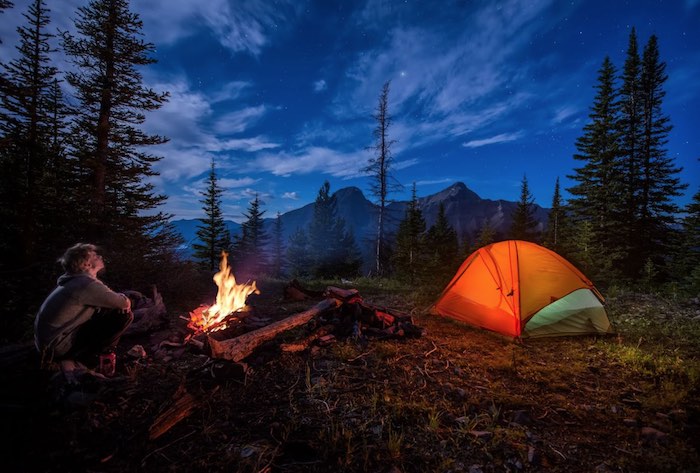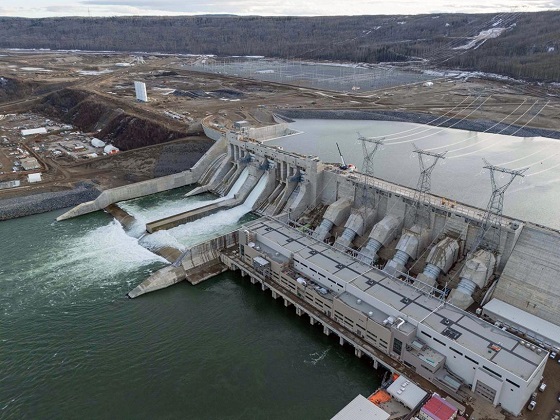Also Interesting
A Guide To Going On An Off-The-Grid Adventure

With our lives becoming increasingly connected online, it’s unsurprising to want to go off the grid for a few days. After all, having the opportunity to separate oneself from constant stimulation is a kind of freedom that’s needed yet difficult to come by. However, simply getting up and deciding to live off-grid from now on is probably too much for some, so the next best option is to go off-the-grid adventuring.
Some assume that living in extreme conditions in the most remote places in the world is what it takes to have an off-the-grid adventure. But having your first off-the-grid adventure by removing all the conveniences of modern technology might put you off from having another trip in the future.
Thus, it’s best to introduce yourself to this type of adventure by removing the technology you can live without. For example, you can take away your access to the internet and Wi-Fi, but it’s probably unrealistic to remove yourself from access to power and water. An off-the-grid trip can be a great way to have an active weekend as you spend more time outdoors and away from your phone.
Here are ways to ensure your adventure goes without a hitch:

1. Pick A Place
The destination you’ve chosen mostly determines how your trip will turn out. Even though you’re going off-grid, it’s best to know all the relevant details of your destination. For example, you may have fees to pay with the National Park Service and certain regulations to follow. It’s also advisable to be familiar with the nature and wildlife in the area to keep yourself safe.
Experienced adventurers know that nature doesn’t pick its victims—and with good reason, considering how merciless the wildlife is to anyone who foolishly stumbles into its territory. But be that as it may, fending the wildlife by inflicting harm isn’t wise, especially if laws protect that species.
Thus, you must research the place you’ve been eying. See if it can accommodate a traveler and provide enough resources for your trip. After all, choosing a portable power station requires knowledge of roughly how much energy you’ll need. This is so you won’t run out of power in the middle of your adventure, saving yourself from inconvenience.
2. Practice Sustainability
Considering you’re surrounded by nature, one way to enjoy your adventure is by utilizing your environment to the fullest, whether it’s the trees or sunlight. They’re your best alternatives for energy sources if you want your trip to last longer without relying too much on your portable power station. You can also practice survival tricks such as building a campfire and using tools like a torch or a rope.
3. Conserve Supplies
As refreshing as it is to pull away from modern life, it removes the conveniences you’re normally used to. Since you only depend on your resources to survive, you must learn how to conserve them.
Be mindful of your power resources. Estimate how much you can use throughout your trip before you deplete them. As for the rest of your supplies, always update your inventory after using them. That way, you can keep better track of them and have a rough timeline of how long they’ll last before you decide it’s time to go home.
4. Be Prepared
Going off the grid with little to no plans over what you’re supposed to do is already a disaster in the making. Inexperienced travelers are unlikely to last long when going off the grid—much less enjoy it. Your off-the-grid adventure should give you solitude away from your busy life, so it’s essential that everything must be prepared to avoid frustration.
Once you’ve found your destination, check it thoroughly. On top of regulations, find out what awaits you at your destination. Learn the best route to get there and see what the path has in store for you, whether they’re mountain ranges or bodies of water. It’s good to study navigation to have an easier time traveling.
While you may have diligently followed the weather forecast before leaving, the weather can still be unpredictable. Instead of only sticking to one kind of gear, it’s better to pack different clothes for various weather conditions, whether for hot days or rainstorms. Ensure that most of what you’re wearing is moisture-wicking to avoid dealing with wet clothes.
Since there’s no way of telling what might happen to you on your trip, prepare survival tools for various scenarios. Have bug spray to avoid being bitten by pests. Bringing bear spray is also a good idea if you’ll be in a place where bears inhabit. Lastly, keep a complete first-aid kit on hand in case of injuries or accidents.
5. Start Slow
Even though you poured days into planning your off-the-grid adventure, it’s still overwhelming once you get into the thick of it. Mistakes are bound to happen on your first trip. Know your limits and only take a short trip for your first time, ideally around a day or two. Use this opportunity to get your feet wet on off-the-grid adventures. Your first experience should give you a better idea of what to do and learn for your next trip. If you encounter any mistakes on your first trip, know that these will only build your skills for future adventures.
Takeaway
It’s easy to get caught up in everything that’s happening around you. After all, keeping up with all your responsibilities is no easy feat. Thus, it’s understandable why you’d like to take an off-the-grid adventure.
As compelling as it is to take a spontaneous adventure, it’s vital to have everything prepared to avoid frustration during your trip. Remember, your off-the-grid adventure should allow you to relax and de-stress.
Also Interesting
A look inside Alberta’s emerging board-game cafés and play spaces

Board-game cafés kind of snuck into Alberta’s cities without anyone making a big fuss about them. One minute they were quirky little spots you only heard about from a friend; now they’re firmly part of the social map. They blend the feel of a neighbourhood coffee shop with walls of games, giving people a place to actually look at each other instead of a screen.
The rise of tabletop hospitality venues across the province
Edmonton and Calgary have become the biggest hubs for these venues, each neighbourhood carving out its own flavour of the trend. A small fee usually opens the door to an entire library of games, quick card titles, sprawling strategy epics, quirky party favourites. Staff members often act as guides more than servers, wandering between tables to help groups find something that fits their mood or to break down complicated rulebooks that would otherwise stall the night.
Behind the scenes, the financial structure resembles other entertainment models built on repeatable, low-friction experiences. Businesses in nearby digital sectors deal with similar puzzles: how to keep guests engaged, how to make payments smooth, how to encourage one more round without pressure. That same focus on smooth, low-friction interactions shows up in entertainment spaces, where platforms face their own version of keeping users engaged and transactions effortless. Operators managing crypto casino options grapple with many of the same moving parts, clean wallet connections, instant confirmations, and blockchain checks that reassure users without slowing anything down. The themes differ, but the operational headaches often rhyme.
Cafés have adjusted their pricing as the scene matures. Memberships and recurring passes appeal to regular players, while newcomers stick to occasional drop-ins. Owners have learned that the business can’t rely solely on cappuccinos and sandwiches; it thrives when the gaming experience itself becomes part of the reason people return.
Interior design philosophies shaping patron experience
Every corner in these cafés is doing a job, even if it looks casual. Big shared tables give groups room to spread out those sprawling, “this might take all night” games, while little booths let pairs hide away with something lighter. The lighting hits that sweet spot, clear enough to read tiny rule cards, soft enough that nobody feels rushed or under a spotlight.
Sound is its own battle. Most nights, the room just hums, not the hush of a library, not the chaos of a bar, but a warm little buzz you melt into. The acoustic panels blend into the décor, soaking up the sharper bursts of laughter so people don’t have to shout. What’s left is a steady murmur that makes the place feel alive without grinding your nerves down.
The shelves? Same attention. They’re arranged with a quiet kind of intention, grouped by vibe and complexity so you don’t burn brain cells before the game even starts. Colour tags help, because no one wants detective work during a night out. Staff keep rotating new favourites into view so the wall actually feels alive, a more curated display than dusty storage.
Game library curation and acquisition strategies
Keeping collections fresh is a constant race. Owners travel to conventions, follow industry chatter and chase limited releases before they disappear. Crowdfunded games introduce another layer of guesswork, forcing cafés to predict which campaigns their communities will care about months before the boxes show up.
Games age quickly under frequent use. Cards bend, boards fray, components vanish. Staff track which titles get the most love so they know when to repair, replace or retire them. It’s a quiet numbers game that ensures the shelves remain filled with well-loved, fully playable sets instead of relics too battered to serve another round.
Some cafés now let customers rent games overnight. The option brings in a little extra income and helps people decide what they might want to buy for their home. It also deepens the relationship between venue and visitor, turning the café into more than a place to sit, it becomes part of the local gaming ecosystem.
Community building through tournaments and organized play
Events are the backbone of customer loyalty. Weekly genre nights gather specific crowds, people who love co-op survival titles, heavy strategy fans, or casual players exploring party games. Monthly tournaments add a competitive spark without turning the atmosphere too serious. Prizes usually come as store credit, keeping the energy local and encouraging return visits.
Publishers often support these efforts. Promotional kits, early-release copies and exclusive launch materials help cafés draw attention and keep regulars excited. These partnerships position the venues as community hubs rather than simply places to sit and play.
Some cafés expand this even further with league systems tracking performance over several weeks. Leaderboards, seasonal finals and long-running rivalries give players a reason to return, turning small gatherings into ongoing storylines embedded in the café’s culture.
Future trajectories for Alberta’s tabletop venue landscape
New cafés are already experimenting with identities of their own. Some build their spaces around nostalgia and retro titles, while others lean toward modern competitive games and tournament play. These niches help venues stand out, even if they narrow the customer base to specific communities.
Technology shows up in subtle ways. Digital catalogues track circulation, online booking systems manage busy nights and analytics help owners understand which games deserve more shelf space. Screens and digital play, however, remain rare; most operators want the experience to stay rooted in the tactile, face-to-face charm that defines the format.
Also Interesting
Keeping Strategic Partnerships On Track with Data Rooms

Strategic partnerships move fast, then stall for familiar reasons: scattered contracts, unclear change control, misaligned KPIs, and painful renewals. A modern virtual data room solves those execution gaps by giving both parties a single, secure workspace to negotiate and govern the relationship.
Below is a practical playbook for partnership for legal and governance teams that need better oversight of the process without slowing the deal.
Why partnerships fail in execution
Alliances now account for a rising share of growth activity, yet many underperform because governance and information flows break down after the signing ceremony. McKinsey has reported sustained growth in partnership activity and the need for rigor in how companies structure and manage complex partner portfolios.
Risk compounds as third parties plug deeper into your tech stack and customer data. KPMG’s recent third-party risk work highlights regulatory pressure and real breach exposure tied to vendor access — amplifying the need for disciplined data, access, and contract controls across the partner lifecycle.
What a VDR contributes that shared drives can’t
Virtual data room services outperform generic cloud folders in four partnership jobs-to-be-done:
- A secure contract repository that centralizes master agreements, statements of work, schedules, and side letters, with version history and tamper-evident audit trails. This is foundational for obligations management and dispute resolution. Research shows that advanced contract lifecycle controls materially reduce missed obligations and improve risk visualization.
- Permissioned partner access so each party sees only what they must. Granular, role-based permissions and watermarking help you share sensitive materials with confidence during escalations or executive reviews. HBR’s long-standing guidance on alliance scorecards underscores the value of clear information rights and accountability, which VDRs operationalize day to day.
- Milestone tracking in VDR to link documents and discussions directly to the KPIs that define success — launch dates, enablement targets, marketing funds, or co-sell quotas — so status never lives in email threads.
- Renewal and compliance files managed in one place for audits, certifications, cybersecurity questionnaires, privacy addenda, and regulatory notices. With regulators sharpening expectations on third-party oversight, having these artifacts organized and provable is no longer optional.
Selecting data room providers for partnerships
In the process of selecting data room providers, you should evaluate top vendors against your partnership-specific needs, not just M&A checklists. Here’s what to pay attention to:
- Granular permissions that support external groups and expiring links.
- Tasking and approvals to shepherd redlines, consent requests, and change orders.
- API and SSO so you can sync with CRM and other tools.
- Audit-quality logs and data residency options for regulated markets.
- Structured dashboards for milestone tracking in VDR without exporting to slides.
If you’re comparing options, check out data room provider reviews at dataroom.org.uk page — a curated platform that evaluates the VDR providers. You’ll find it useful if you want your partnerships to run for years rather than weeks.
Designing the core folder architecture
Once you have a decent data room selected, you’re ready to think about folder architecture. Experienced teams use a common structure across deals so stakeholders can find the right file in seconds. A typical data room for partnerships includes:
- Governance — charters, joint steering deck, RACI, escalation paths, meeting minutes.
- Contracts — MSA, SOWs, pricing exhibits, data protection terms, change orders.
- Delivery — technical specs, APIs, integration test evidence, rollout plans.
- Commercials — business cases, rebate logic, MDF claims, sales playbooks.
- Compliance & risk — SOC/ISO reports, penetration tests, DPIAs, DPA annexes.
- Performance & KPIs — dashboards, QBR packs, remediation logs.
- Renewal & amendments — redlines, approvals, countersigned documents.
Keep naming conventions strict (e.g., YYYY-MM-DD_DocumentName_Vx), and map folders to contract clauses so audits are traceable to obligations.
Access control that matches real-world roles
Partnerships span legal, finance, security, product, marketing, and sales on both sides. Use the VDR’s permission model to mirror this:
- Internal core team: full read/write within governance, contracts, and delivery.
- Partner core team: scoped access to execution materials, not internal approvals.
- Executives and board: read-only to governance and KPI packs for QBRs.
- Specialists (security, privacy, tax): time-boxed, watermark-protected access to specific subfolders.
This permissioned access keeps collaboration fluid while containing risk if membership changes mid-stream.
From diligence to day 2: Workflows that prevent drift
VDRs shine when you operationalize a few high-leverage workflows:
- Vendor due diligence. Host questionnaires, evidence, and remediation in one trackable space. Thomson Reuters outlines the scope of effective vendor due diligence; your VDR should reflect that scope with structured folders, checklists, and deadlines.
- Security events. Keep incident notifications, joint response notes, and root-cause analyses in the compliance area with restricted access.
- Quarterly business reviews. Publish dashboards, opportunity lists, pipeline hygiene notes, and joint marketing calendars under a single Quarterly Business Review (QBR) folder — reducing prep time and increasing continuity across sponsors.
Contract intelligence that keeps money on the table
Money usually leaks in quiet ways: someone forgets to pay a rebate, prices don’t get updated, or a service promise keeps auto-renewing without anyone checking it. To stop that, you write down the most important details from each deal — like when it renews, how prices can change, what refunds are owed if something breaks, and when special rights end — and you keep those in one safe place everyone can see.
Then you set five important reminders in that same place:
- When the deal is about to renew
- When it’s time to review prices
- When you need to check rebates after each quarter
- When you need to make sure a broken promise got a credit
- When “only we’re allowed to do this” ends
Each reminder should have one person in charge, a due date, and proof saved before anyone can say it’s done.
How to launch a partner VDR in 30 days
You don’t need a massive program to see value. In four weeks, you can stand up a partner-ready data room that legal, security, and sales will actually use:
Week 1 — Foundation. Confirm the folder taxonomy, map documents to contract clauses, and assign owners. Set baseline permissions and watermark settings.
Week 2 — Migration. Move authoritative versions only; archive duplicates. Create a secure contract repository and lock naming conventions.
Week 3 — Workflows. Configure diligence and change-control checklists, SLA tracking, and QBR templates. Enable alerts for renewals and audits.
Week 4 — Operate. Run a QBR using VDR dashboards, test guest invites with permissioned partner access, and review logs. Document playbooks for handoffs if needed.
Partnership pilot programs are forgiving; scale is not. As your partnership expands, decision rights blur, metrics drift, and files scatter. Your VDR should prevent that: one place for obligations, KPIs, and audits, all tied to owners and dates.
Don’t wait for a customer review or regulator to force the issue. Stand up the folder model, set renewal and control alerts, and use QBRs from the data room — not slides.
-

 Digital ID2 days ago
Digital ID2 days agoCanada releases new digital ID app for personal documents despite privacy concerns
-

 Bruce Dowbiggin2 days ago
Bruce Dowbiggin2 days agoNFL Ice Bowls Turn Down The Thermostat on Climate Change Hysteria
-

 Community2 days ago
Community2 days agoCharitable giving on the decline in Canada
-

 Energy2 days ago
Energy2 days agoCanada’s sudden rediscovery of energy ambition has been greeted with a familiar charge: hypocrisy
-

 Crime2 days ago
Crime2 days agoTrump designates fentanyl a ‘weapon of mass destruction’
-

 Energy2 days ago
Energy2 days agoCan we not be hysterical about AI and energy usage?
-

 Energy2 days ago
Energy2 days agoEnergy security matters more than political rhetoric
-

 Alberta1 day ago
Alberta1 day agoCanada’s New Green Deal






